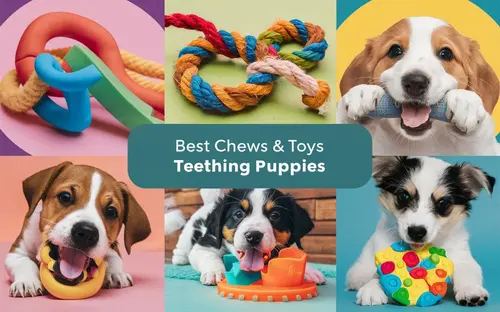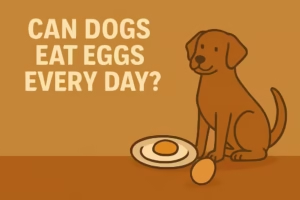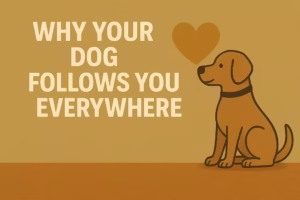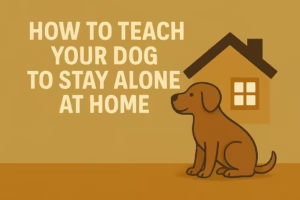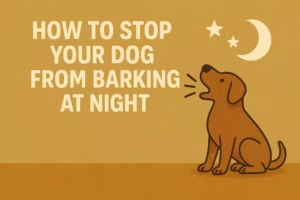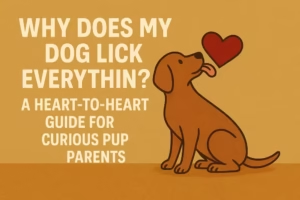Watching your new puppy go through the teething process can be both adorable and concerning. On one hand, those tiny needle-sharp puppy teeth are a rite of passage. But on the other, that determined little land shark can destroy everything in sight when those sore gums start throbbing.
As a puppy parent, it’s your job to stock up on safe, long-lasting chew toys and edibles to satisfy that intense urge to gnaw. The right chews can soothe aching gums while also discouraging destructive chewing behaviors. But how do you pick the best options? This guide is here to help!
Why Puppies Need to Chew During Teething
Teething is a completely normal and necessary phase of puppy development. Those tiny razor-sharp milk teeth start emerging around 2-3 weeks old. Then the 28 puppy teeth are gradually replaced by 42 adult teeth over the next 5-8 months.
During this extended teething process, puppies experience significant oral discomfort and inflammation from:
- Teeth erupting through the gums
- Shifting teeth and jaw alignment
- Tooth roots lengthening
This causes an extremely strong, hard-wired instinct to chew and gnaw on anything available. Chewing behaviors help:
- Relieve pressure and pain in the gums
- Massage the gums and jaw muscles
- Help loosen and pull out stubborn baby teeth
So as frustrating as all that persistent gnawing can be, it’s a vital need that you need to satisfy with safe, stimulating chew toys and edible chews.
Safety First – Chew Toys to Avoid
Before we dive into great chew options, let’s cover some definite no-no’s when it comes to puppy chew items. Many common household items can pose serious safety risks like:
- Clothing items like socks, shirts, etc. Strings and threads can cause dangerous intestinal obstructions if swallowed.
- Cooked bones of any kind. While puppies can have edible raw bones, cooked bones become dry and brittle which can splinter off into sharp pieces.
- Plastic items like kids’ toys or household objects. These can easily break apart into small pieces that present a choking hazard.
- Plush stuffed animals. These are major hazards as puppies will ingest stuffing and small pieces.
- Sticks from outside. Stick ends can splinter and cause oral lacerations or perforations if swallowed.
It’s always best to stick with dog chew toys specifically designed for safety, appropriate size, and durability based on your pup’s age, breed, and chew drive.
The Top Chews and Toys for Teething Relief
With those dangers out of the way, let’s look at some of the best chew options that are safe, healthy, and made to endure the endless jaws of a teething pup! Every puppy is a little different in their preferences and needs, so a variety of textures and chew styles is ideal.
Long-Lasting Edible & Digestible Chews
These chewy treats can be safely ingested as your puppy works on them over time:
- Bully sticks – Made from a single beef muscle, these are a protein-rich classic that can endure heavy chewers. Plus they help keep teeth clean!
- Yak/Buffalo chews – These hard cheese chews made from yak and buffalo milk last much longer than typical dog treats.
- Dehydrated sweet potato slices – A favorite veggie chew that’s firm yet edible and full of vitamins.
- Hoof chews – Dehydrated cow hooves are packed with calcium and last a very long time.
Give Frozen Treats a Try!
Does your pup love crunching on ice cubes in the summer? Then frozen chews and toys can provide much-needed relief too! Try soaking chew ropes in water or low-sodium broth and freezing them. Or stuff a rubber chew toy with wet dog food, close it up, and freeze before giving it to your pup!
Tough & Durable Non-Edible Chew Toys
For more heavy-duty chewing satisfaction, consider longer-lasting non-edible toys and chews:
- Elk or deer antlers – These naturally shed antlers are extremely dense and tough, designed to gradually wear down puppy teeth.
- Rubber chew toys – Look for thick, durable rubber toys with grooved textures that massage sore gums. The best are made from non-toxic, natural rubber.
- Rope toys – Woven cotton or rubber ropes allow puppies to safely pull and tug to soothe those aching jaws. Double-knot the ends!
- Hard plastic or nylon chews – These synthetic chews like Nylabones and Goughnuts are long-lasting yet pliable enough to avoid dental damage.
Rotate for Novelty!
Puppies can quickly get bored with the same old chew toys, so keep things interesting by frequently rotating different shapes, textures, flavors, and styles of chew toys and edibles. Having a variety on hand prevents destructive chewing behaviors.
Safe & Creative Frozen Chew Options
We already mentioned frozen chews, but this category deserves its own section! Freezing various edible and non-edible items provides a satisfying mix of soothing cold relief and interesting, long-lasting chewing entertainment.
Some ideas and pro tips:
- Freeze wet washcloths for safe, extended puppy gnawing. The cold helps inflamed gums while the soft cloth won’t damage new teeth.
- Make chilled “pupsicles” by freezing diluted low-sodium broths or fruit/veggie purees in cupcake tins or chew toys.
- Fill an old kitchen towel with treats and knot the ends before freezing for an engrossing food-dispensing chew puzzle.
- Look for freezer-safe rubber toys you can stuff with treats or peanut butter before freezing.
Just be sure to supervise while your puppy enjoys these frozen delights to prevent choking hazards. And never leave your pup unattended with towels or fabrics.
Choosing Safe & Appropriate Chews and Toys
With so many options, how do you decide what’s right for your pup? Safety, size-appropriateness, and supervision are key!
Chew Size Does Matter!
Pay close attention as well to whether your puppy is an aggressive “shredder” of chews. If they tend to quickly break off small pieces, opt for sturdier one-piece chew toys and edibles over multi-component items that could present ingestion hazards.
Always Supervise Chew Time
No chew toy is 100% risk-free, so it’s crucial to supervise your teething puppy any time they have a new chew. Check regularly for any signs of tearing, splintering, or pieces breaking off that could become choking hazards.
Some additional tips for safe supervised chewing:
- Set limits on chew sessions to avoid over-indulging which can lead to digestive issues.
- Provide chews only when you can actively watch – never leave them unattended.
- Hide or pick up all chews when playtime is over to avoid accidental ingestion.
- Check gums periodically for any excessive bleeding or abnormalities.
When in Doubt, Take it Away!
If your puppy seems to be damaging a chew toy to the point it may become unsafe, it’s better to be safe than sorry. Simply take it away and replace it with a fresh chew option. Their safety is top priority!
How to Introduce New Chew Toys
With any new chew, it’s wise to do a gradual introduction and monitor closely for safety. Here are some tips:
- Let your puppy sniff and investigate the new chew first before giving it to them.
- Offer new chews when your pup is calm to help build positive associations.
- Stick with short 5-10 minute supervised sessions at first.
- Distract and swap for a different chew option if your puppy gets overly obsessed.
- Use positive reinforcement like treats to reward gentle, appropriate chewing.
Rotating for Enrichment and Safety
As mentioned earlier, having a variety of different chew toys and constantly rotating the options provides both physical and mental enrichment for your puppy. Mixing things up:
- Prevents accidental overuse of one chew that could cause digestive upset
- Discourages obsessive resource-guarding of favorite chews
- Keeps things novel and exciting to hold your pup’s attention
Aim to swap out chew toys daily or every few days for optimal safety and enrichment during the teething process.
The Benefits of Safe, Appropriate Chews
While chew toys provide obvious relief benefits during teething, they offer additional value too:
- Discourage destructive chewing on household items when you provide appealing alternate options
- Keep jaws strong & healthy through the exercise of chewing
- Alleviate boredom & restlessness by giving your pup a job to do
- Promote calmness since chewing is a self-soothing behavior
- Bonding time when you participate in chew toy games and training
Chewing is also mentally enriching as it engages your puppy’s natural instincts for exploration, play, and “hunting.”
Conclusion
As demanding as the teething stage can be, it’s a natural phase you can get through safely and successfully with the right chew toys and edibles. With proper supervision and an assortment of age-appropriate, durable, and engaging chew options, you can satisfy your puppy’s gnawing needs while avoiding dangerous alternatives.
The investment in quality chew toys now pays off in preventing destructive chewing habits down the road. So stock up and let the healthy, happy chewing frenzy begin! Your puppy’s baby teeth ache is about to meet its match.
File size
Teething Puppy Chew FAQs
- How long will my puppy’s teething last?
The entire teething process from emergence of the first puppy teeth to loss of the final baby teeth typically lasts 5-8 months on average. - Can I give my puppy rawhide chews?
Rawhide chews pose risks like choking, digestive obstructions, and contamination, so most vets advise avoiding them for puppies. Stick to safer digestible options. - My puppy is preferring to chew on my shoes over his toys. What can I do?
Be sure to provide a variety of different textures and materials in his chew toy selection, and rotate new options frequently for novelty. You can also try spritzing shoes with bitter apple spray as a deterrent. - How can I tell if a chew toy is too hard for my puppy’s baby teeth?
Observe for signs of excessive bleeding or your puppy giving up quickly in frustration, which could indicate the chew is too firm. Also avoid anything as hard as nylon bones or hooves until your pup’s adult teeth arrive. - Why does my puppy get the”zoomies” after a big chew session?
Chewing actually has a calming effect that releases endorphins for your pup. Those energetic zoomies are just their way of burning off some built-up, post-chewing puppy energy!

